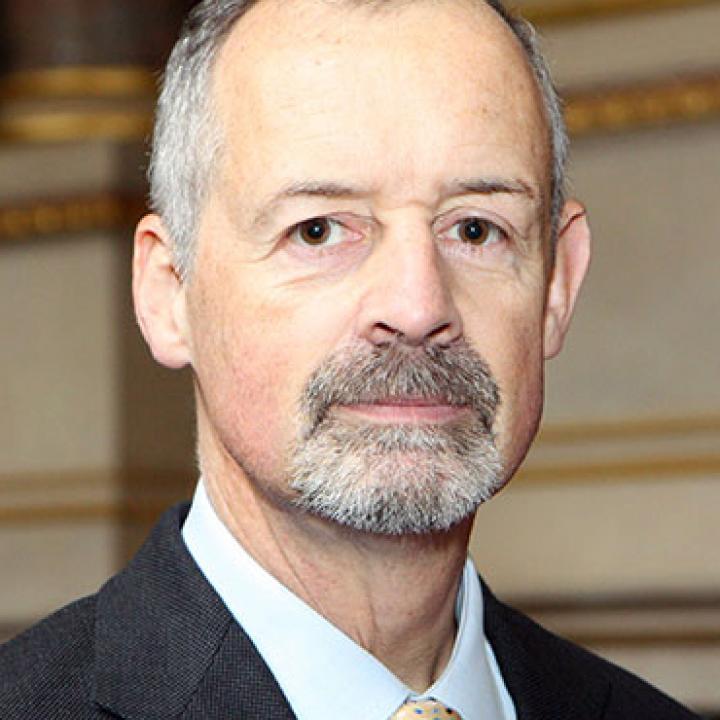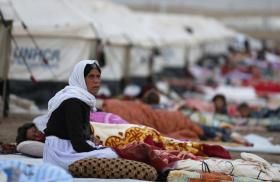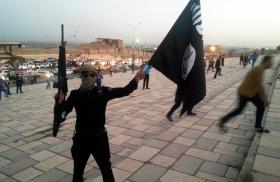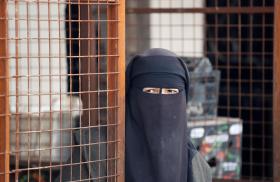
- Policy Analysis
- Policy Forum
The Persistent Threat from the Islamic State and Al-Qaeda: The View from the UN

Part of a series: Counterterrorism Lecture Series
or see Part 1: U.S. Efforts against Terrorism Financing: A View from the Private Sector
The head of the UN team charged with monitoring each group assesses their prospects for bouncing back and recommends further steps that governments can take to counter them.
On February 6, Edmund Fitton-Brown, coordinator of the UN Analytical Support and Sanctions Monitoring Team, addressed a Policy Forum at The Washington Institute. The following are his prepared remarks.
The Monitoring Team was created in 2004 to support the committee charged with implementing UNSCR 1267 (1999) and imposing sanctions on the Taliban, al-Qaeda, and those individuals, groups, and entities associated with these terrorist organizations. Through a succession of update resolutions between then and 2017, the team now supports two successor UNSC committees: the “Security Council Committee pursuant to Resolutions 1267 (1999), 1989 (2011), and 2253 (2015) concerning Islamic State in Iraq and the Levant (Da’esh), Al-Qaida, and associated individuals, groups, undertakings, and entities” (aka the 1267 Committee), which focuses on ISIL and al-Qaeda, and the 1988 Sanctions Committee, which deals with sanctions relating to the Taliban.
Today, I will focus specifically on the team’s recent findings with regard to the global threat posed by ISIL and al-Qaeda. Before doing so, however, I will provide a brief overview of the mandate and responsibilities of the Monitoring Team.
The al-Qaeda Analytical Support and Sanctions Monitoring Team comprises ten experts from ten member states and is based in New York. It supports the Security Council by:
- Assessing the global threat from ISIL and al-Qaeda in biannual reports and in regular oral briefings to the 1267 Committee, and by drafting the threat part of the UN Secretary General’s regular ISIL report. In addition, once a year, we report on the threat posed by the Taliban to peace and stability in Afghanistan.
- Collecting information from member states on individuals and entities on the al-Qaeda and 1988 sanctions lists, to ensure these designations remain updated, accurate, and detailed enough for conclusive identification. In a similar vein, we travel extensively to member states to raise awareness of the sanctions regimes and generate new designation proposals.
- Preparing and presenting recommendations to make the three sanctions measures (asset freezes, travel bans, and/or arms embargos) more effective. We also aim to improve sanctions implementation and member state compliance.
In furtherance of these missions, the team works on its global mandate with member states, UN missions and agencies, and other relevant bodies. For example, we collaborate with Interpol, the International Civil Aviation Organization, the World Customs Organization, the Financial Action Task Force (FATF), and FATF’s regional bodies. We also collaborate with relevant private sector entities in assessing the changing nature of the terrorist threat and enhancing sanctions compliance.
We are explicitly mandated to “consult in confidence with member states’ intelligence and security services,” distinguishing us from other UN entities. In this way, we offer a significant niche capability to the UN’s overall counterterrorism (CT) effort. Our assessment of the threat provides part of the basis for other UN CT entities’ issue prioritization.
Additionally, to support intra-UN synergies and efficiency, the team works with the Office of Counter-Terrorism and the Counter-Terrorism Executive Directorate. We participate in the UN Global Counter-Terrorism Strategy—including the UN Global Counter-Terrorism Coordination Compact and its working groups—and collaborate with other entities that are signatories to this framework.
The team also organizes periodic closed regional meetings for the CT leaderships of intelligence and security services in various strategic parts of the world, contributing to the UN objective of generating and enhancing cooperation between and amongst member states’ CT agencies. The team is also mandated by various resolutions to develop information on specific issues during our consultations with member states, including: foreign terrorist fighters (FTFs); human trafficking; sexual violence; illicit trade in antiquities and cultural property; terror finance; links between terrorism and organized crime; terrorist acquisition of arms; and threats to aviation security.
KEY TRENDS IN THE THREAT LANDSCAPE
Regarding the global threat posed by ISIL and al-Qaeda, I will draw on the Monitoring Team’s twenty-fifth report, which was completed at the end of December 2019 and is now available online. Though the report covers the second half of 2019, I will also touch on several key developments from earlier last year in my remarks.
The first significant development that warrants mention is the military defeat of ISIL, completed in eastern Syria in March 2019. Although the fall of Baghuz marked the defeat of the “geographical caliphate,” it also precipitated a larger than expected movement of ISIL fighters, supporters, dependants, and other refugees and displaced persons. In light of mass internal displacement, overcrowding in refugee camps such as al-Hawl, and precarious holding arrangements, humanitarian and security challenges demand urgent attention. However, clear, comprehensive, and multilateral solutions remain elusive.
The second event that I believe deserves attention is the Easter Sunday Sri Lanka bombings, during which three churches and three luxury hotels in Colombo were targeted, followed by smaller explosions at a housing complex in Dematagoda and a guest house in Dehiwala. The mass-casualty attacks—which killed 259 individuals, including 25 foreign nationals—are demonstrative of ISIL’s increasingly decentralized structure and international base of support. The group’s claim of responsibility via its Amaq News Agency on April 23, 2019, and the attackers’ inspiration by ISIL’s ideology illustrate the group’s ability to endure, recruit, and radicalize abroad, even absent direct command and control of attacks.
Indeed, ISIL-core had no advance warning of the Easter Sunday attacks. ISIL caliph Abu Bakr al-Baghdadi’s late April reference was merely an afterthought. Nonetheless, an ISIL-inspired group had incubated in Sri Lanka and developed a significant capability. While it had foreign links, the cell was locally generated, financed, and led.
The shock value and scale of the Sri Lankan attacks were a boon to the homegrown terrorist threat. More ISIL-inspired attacks (though hopefully not on the same scale as Sri Lanka’s) are likely in 2020, with the added motive of avenging Baghdadi’s death. However, given that these inspired attacks tend to be unreliable and relatively low-impact, ISIL might also revive its own external operations capabilities.
THE CONTINUED THREAT IN IRAQ AND SYRIA
Today in Iraq and Syria, the process of stabilization and reconstruction remains slow. Political tensions do not help.
ISIL’s covert network in Syria is being established at the provincial level, a mirror image of what we have seen in Iraq since 2017. In its core area, it is adapting, consolidating, creating conditions for its eventual resurgence. As the group grows in confidence, it is operating ever more openly.
Northwestern Syria is a base for many extremists, including FTFs. As the recent Monitoring Team report noted, member states continue to assess that between one half and two thirds of the more than 40,000 who joined the “caliphate” are still alive.
Al-Qaeda-aligned Hayat Tahrir al-Sham (HTS) and Hurras al-Din (HAD) also remain active in the area. While ISIL has taken a back-seat in fighting Syrian forces (as long as it is able to retain a presence in the area), HTS currently has 12,000 to 15,000 fighters, mainly focused on combating Syrian government forces. HAD is assessed to have between 3,500 and 5,000 fighters and also operates in Idlib and its surrounding areas.
The return to normal in Iraq and the Levant won’t be easy, and absent political stability, there is a vacuum of power to be exploited by terrorists.
ISIL LEADERSHIP AND PLANNING: BAGHDADI TO QURAYSHI
The killing of Abu Bakr al-Baghdadi in late October was another key event of 2019. Before his death in Barisha, Baghdadi urged efforts to free ISIL fighters and dependants accommodated in facilities in northeastern Syria, such as al-Hawl refugee camp.
Many ISIL leaders are indeed hiding in Iraq and Syria. ISIL discriminates between its personnel, and while foot soldiers, including many FTFs, are seen as dispensable, key seniors are kept safe. In this vein, Syrian and Iraqi leaders are favoured over their foreign counterparts.
ISIL’s somewhat cavalier attitude toward its foreign contingent may cost the group in terms of future opportunities. In contrast with regular operations in the core area and some remote provinces, directed international attacks are still way down from their 2015/16 levels, as are the number of facilitated and inspired attacks.
This decline in external operations may not turn imminently, but with time and space to recoup and reorganize in its safe haven, ISIL will once again start to project an organized threat. Once its survival is assured, ISIL will reinvest in its external operations capability, possibly in unexpected locations. We have seen signs of this happening with ISIL and al-Qaeda.
ISIL certainly has the financial reserves to assist in this. Some estimates place the group’s finances at 100 to 300 million dollars. Additionally, member states have reported that ISIL in Iraq continued to finance its operations through investing in legitimate businesses and commercial fronts, including money exchange companies.
Turning to leadership succession, following Baghdadi’s death and the public announcement of Abu Ibrahim al-Hashimi al-Qurayshi as his successor, there has been unconfirmed reporting that Abu Ibrahim is Amir Muhammad Said Abdal Rahman al-Mawla, an established senior who previously served as Baghdadi’s deputy.
After the announcement of Abu Ibrahim’s appointment, the ISIL central media bureau choreographed through propaganda outlets a series of pledges of allegiance from supporters claiming to be in Sinai, Bangladesh, Somalia, Pakistan, Yemen, Khorasan Province (Afghanistan), and a number of other countries. But ISIL will find it hard to sustain this initial level of enthusiasm over al-Qurayshi without compromising the new leader’s security.
Because putting Qurayshi on screen might pose danger to his security, the transition of authority might accelerate the delegation of authority from ISIL-core to its affiliates, even if Abu Ibrahim is al-Mawla and strategy remains consistent.
AL-QAEDA LEADERSHIP AND PLANNING: LOOKING AHEAD
We learned in September that Osama bin Laden’s son Hamza had been killed some while ago. Meanwhile, current al-Qaeda leader Ayman al-Zawahiri is in poor health. Given these two developments, it is important to pre-emptively consider what direction Abu Muhammad al-Masri, Zawahiri’s presumed successor, will take al-Qaeda.
It is also interesting to note al-Qaeda’s conservatism with regard to resourcing operations. Al-Qaeda tends to prioritize its administrative costs and salaries. Despite external attack ambitions by groups like al-Qaeda-affiliated Hurras al-Din in Syria’s Idlib province, such affiliates remain curtailed by both military pressure and al-Qaeda’s own reluctance to resource such operations.
INTERNATIONAL TERRORISM: AFGHANISTAN, AFRICA, AND EUROPE
As the recent Monitoring Team report notes, “Afghanistan continues to be the conflict zone of greatest concern to member states outside the ISIL core area and suffers by some measures the heaviest toll from terrorism of any country in the world.” ISIL’s Khorasan Province (ISIL-K) remains the group’s centre of gravity in South Asia. In fact, the UN’s 1267 Committee recently sanctioned ISIL-K as a separate entity. The group is resilient, launching attacks with impact disproportionate to its numbers, even in Kabul, where it conducts propaganda activities in madrasas and universities.
ISIL-K has had a difficult year, ending with eradication of its Nangarhar base. We now assess its fighting strength at no more than 2,500 individuals, the great majority of whom are currently in Kunar Province. Nonetheless, ISIL-K is still recruiting new members, and ISIL might develop an external operations capability in Afghanistan.
Many al-Qaeda and Taliban-aligned extremist groups are also present in Afghanistan. al-Qaeda’s relationship with the Taliban continues to be close and mutually beneficial, with the former supplying resources and training in exchange for protection. Central Asian neighbours fear a potential cross-border threat from these as well as from ISIL.
Afghan politics and the peace process are evolving, and it is vital to revive talks and bring peace to Afghanistan; indeed, reconciliation is the main driver behind our 1988 work. However, there may be short term costs associated with peace negotiations, such as driving individuals to join ISIL-K and/or pursue terrorist plans more actively. It is not clear what impact diplomatic developments will have on the external threat, but if a peace agreement is reached, al-Qaeda intends to develop a new narrative to justify continuing the armed conflict in Afghanistan.
Meanwhile, a continuum of instability is emerging in West Africa and the Sahel. Extremists threaten fragile regional states. Al-Qaeda-aligned Jamaat Nusrat al-Islam wal-Muslimin (or JNIM) represents the principal international terrorist threat in the region, and its operational efficiency is maximized by deconfliction and operational collaboration with other terrorist groups active in the region, such as the Islamic State in the Greater Sahara (ISGS) in Mali and Niger and Ansarul Islam in Burkina Faso.
Particularly in Africa, ISIL has been devolving authority, allowing its most prominent affiliates to lead lesser ones in the same region. For example, IS West Africa Province (ISWAP) in Nigeria has grown in ambition and now claims attacks on behalf of ISGS.
Facing a different primary set of issues, in Europe, authorities seem at cross-purposes, unsure how best to handle domestic extremists, returning FTFs, and frustrated travellers. Radicalization in prisons and the release of extremist prisoners are also growing challenges, as demonstrated by the recent attacks by Usman Khan and Sudesh Amman in the United Kingdom. Additionally, many of the foreign terrorist fighters who received relatively short sentences upon their return to Europe prior to 2015 are expected to be released in the coming period. Many states in Europe, never mind poorer countries elsewhere, lack the resources to address this host of issues.
CONCLUSION
ISIL’s military defeat and the death of Baghdadi should be welcomed as good news. But the whole nexus of post-caliphate issues—what to do with people who fought for ISIL, worked for it, and/or lived under it—is massive. More than 40,000 travelled to join this struggle; a rough calculation of the attrition rate suggests 25,000-plus FTFs may still be alive. We have detainees, fugitives, returnees, and relocators, and some dependants may also pose a potential threat.
The international community will face short, medium and long-term risks if we mismanage these challenges. The fight against extremism is a generational problem. The case of an Indonesian FTF killed in Syria in 2018—himself the child of one of the bombers in the 2002 Bali bombing—exemplifies how mishandled grievances can fuel continued radicalization and recruitment.
Unfortunately, I believe the underlying conditions exist for this strain of jihadist terrorism to be with us for a long time, whether in the form of ISIL (under its more or less effective new leader), al-Qaeda (sooner or later under a successor to Zawahiri), mutations like jihadi nationalism, multi-group coalitions like JNIM, or a new brand as little known now as ISIL was before 2014.
The Policy Forum series is made possible through the generosity of the Florence and Robert Kaufman Family.






